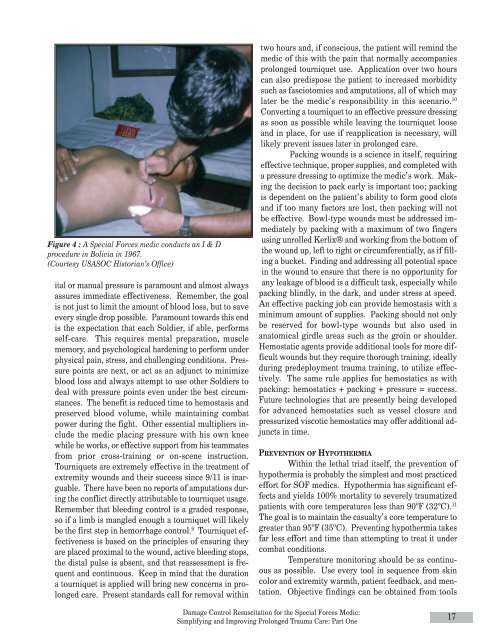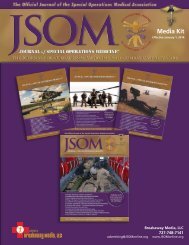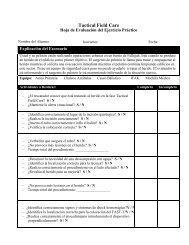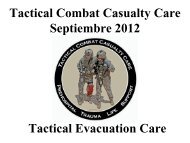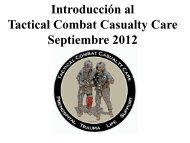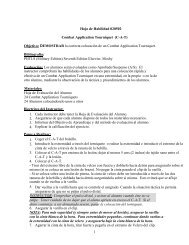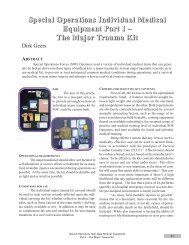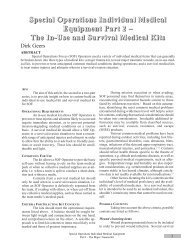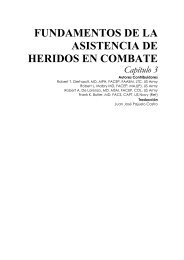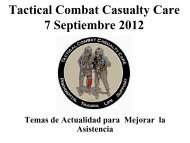Risk G. Hetzler M. Damage Control Resuscitation for the Special ...
Risk G. Hetzler M. Damage Control Resuscitation for the Special ...
Risk G. Hetzler M. Damage Control Resuscitation for the Special ...
You also want an ePaper? Increase the reach of your titles
YUMPU automatically turns print PDFs into web optimized ePapers that Google loves.
Figure 4 : A <strong>Special</strong> Forces medic conducts an I & D<br />
procedure in Bolivia in 1967.<br />
(Courtesy USASOC Historian’s Office)<br />
ital or manual pressure is paramount and almost always<br />
assures immediate effectiveness. Remember, <strong>the</strong> goal<br />
is not just to limit <strong>the</strong> amount of blood loss, but to save<br />
every single drop possible. Paramount towards this end<br />
is <strong>the</strong> expectation that each Soldier, if able, per<strong>for</strong>ms<br />
self-care. This requires mental preparation, muscle<br />
memory, and psychological hardening to per<strong>for</strong>m under<br />
physical pain, stress, and challenging conditions. Pressure<br />
points are next, or act as an adjunct to minimize<br />
blood loss and always attempt to use o<strong>the</strong>r Soldiers to<br />
deal with pressure points even under <strong>the</strong> best circumstances.<br />
The benefit is reduced time to hemostasis and<br />
preserved blood volume, while maintaining combat<br />
power during <strong>the</strong> fight. O<strong>the</strong>r essential multipliers include<br />
<strong>the</strong> medic placing pressure with his own knee<br />
while he works, or effective support from his teammates<br />
from prior cross-training or on-scene instruction.<br />
Tourniquets are extremely effective in <strong>the</strong> treatment of<br />
extremity wounds and <strong>the</strong>ir success since 9/11 is inarguable.<br />
There have been no reports of amputations during<br />
<strong>the</strong> conflict directly attributable to tourniquet usage.<br />
Remember that bleeding control is a graded response,<br />
so if a limb is mangled enough a tourniquet will likely<br />
be <strong>the</strong> first step in hemorrhage control. 9 Tourniquet effectiveness<br />
is based on <strong>the</strong> principles of ensuring <strong>the</strong>y<br />
are placed proximal to <strong>the</strong> wound, active bleeding stops,<br />
<strong>the</strong> distal pulse is absent, and that reassessment is frequent<br />
and continuous. Keep in mind that <strong>the</strong> duration<br />
a tourniquet is applied will bring new concerns in prolonged<br />
care. Present standards call <strong>for</strong> removal within<br />
two hours and, if conscious, <strong>the</strong> patient will remind <strong>the</strong><br />
medic of this with <strong>the</strong> pain that normally accompanies<br />
prolonged tourniquet use. Application over two hours<br />
can also predispose <strong>the</strong> patient to increased morbidity<br />
such as fasciotomies and amputations, all of which may<br />
later be <strong>the</strong> medic’s responsibility in this scenario. 10<br />
Converting a tourniquet to an effective pressure dressing<br />
as soon as possible while leaving <strong>the</strong> tourniquet loose<br />
and in place, <strong>for</strong> use if reapplication is necessary, will<br />
likely prevent issues later in prolonged care.<br />
Packing wounds is a science in itself, requiring<br />
effective technique, proper supplies, and completed with<br />
a pressure dressing to optimize <strong>the</strong> medic’s work. Making<br />
<strong>the</strong> decision to pack early is important too; packing<br />
is dependent on <strong>the</strong> patient’s ability to <strong>for</strong>m good clots<br />
and if too many factors are lost, <strong>the</strong>n packing will not<br />
be effective. Bowl-type wounds must be addressed immediately<br />
by packing with a maximum of two fingers<br />
using unrolled Kerlix® and working from <strong>the</strong> bottom of<br />
<strong>the</strong> wound up, left to right or circumferentially, as if filling<br />
a bucket. Finding and addressing all potential space<br />
in <strong>the</strong> wound to ensure that <strong>the</strong>re is no opportunity <strong>for</strong><br />
any leakage of blood is a difficult task, especially while<br />
packing blindly, in <strong>the</strong> dark, and under stress at speed.<br />
An effective packing job can provide hemostasis with a<br />
minimum amount of supplies. Packing should not only<br />
be reserved <strong>for</strong> bowl-type wounds but also used in<br />
anatomical girdle areas such as <strong>the</strong> groin or shoulder.<br />
Hemostatic agents provide additional tools <strong>for</strong> more difficult<br />
wounds but <strong>the</strong>y require thorough training, ideally<br />
during predeployment trauma training, to utilize effectively.<br />
The same rule applies <strong>for</strong> hemostatics as with<br />
packing: hemostatics + packing + pressure = success.<br />
Future technologies that are presently being developed<br />
<strong>for</strong> advanced hemostatics such as vessel closure and<br />
pressurized viscotic hemostatics may offer additional adjuncts<br />
in time.<br />
PREVENTION OF HYPOTHERMIA<br />
Within <strong>the</strong> lethal triad itself, <strong>the</strong> prevention of<br />
hypo<strong>the</strong>rmia is probably <strong>the</strong> simplest and most practiced<br />
ef<strong>for</strong>t <strong>for</strong> SOF medics. Hypo<strong>the</strong>rmia has significant effects<br />
and yields 100% mortality to severely traumatized<br />
patients with core temperatures less than 90ºF (32ºC). 11<br />
The goal is to maintain <strong>the</strong> casualty’s core temperature to<br />
greater than 95ºF (35ºC). Preventing hypo<strong>the</strong>rmia takes<br />
far less ef<strong>for</strong>t and time than attempting to treat it under<br />
combat conditions.<br />
Temperature monitoring should be as continuous<br />
as possible. Use every tool in sequence from skin<br />
color and extremity warmth, patient feedback, and mentation.<br />
Objective findings can be obtained from tools<br />
<strong>Damage</strong> <strong>Control</strong> <strong>Resuscitation</strong> <strong>for</strong> <strong>the</strong> <strong>Special</strong> Forces Medic:<br />
Simplifying and Improving Prolonged Trauma Care: Part One<br />
17


